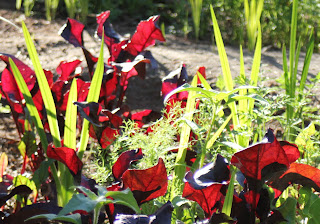Lettuce, as an above-ground, leafy crop, likes a lot of nitrogen. In regular crop roatation, lettuce should follow beans or peas, which "fix" soil by putting nitrogen in the ground. To prepare the lettuce bed, I start by digging deeply - 8" to 10" - to break up the soil. Then I remove the top 4" (adding to compost pit), and replace with a top dressing of rich, loamy compost. Then dig this in. Planting lettuce is easy in that you can scatter the seed directly onto the ground. Cover with a scant 1/4" of dirt and water well. It is important to keep the seeds moist, or they will not sprout.
For personal use we leave the seedlings close together. To harvest, you just cut off the tops of the leaves with a scissors like a hedge. More will grow. For market, we transplant and spread out individual seedlings in mid February, to about 6" apart. Those will be ready to harvest as head lettuce starting in early April.
Lettuces, besides being an excellent source of fibre, also pack a punch with vitamins A, K and C, and the B-complex vitamins, beta-carotene, and with minerals such as iron, calcium, magnesium and potassium. A salad a day . . .

Blood Red Beets, shown here, are generally grown for their gorgeous & nutrient-rich leaves, so I have started harvesting just the outside leaves and adding to my daily salads. They are so beautiful, and I can't wait 'til we harvest the full bulb, even though I don't really like beets. Maybe this year we will discover a recipe I like!


No comments:
Post a Comment